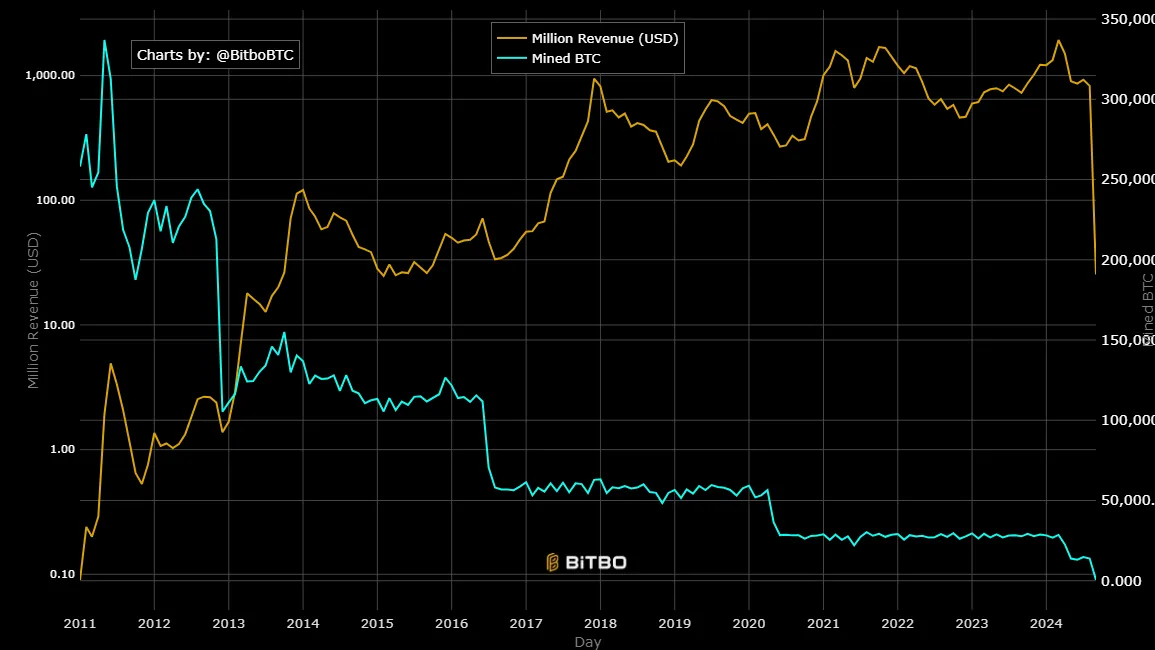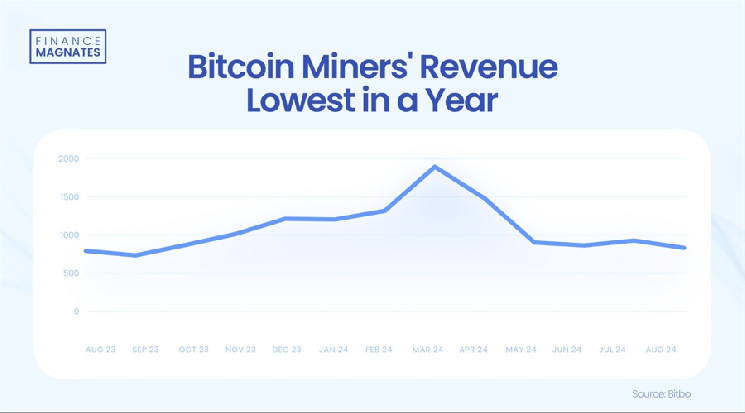Wall Street's Bitcoin Miners Haven't Seen Such Weak Revenues in a Year
 financemagnates.com 02 September 2024 14:33, UTC
financemagnates.com 02 September 2024 14:33, UTC Wall Street Bitcoin (BTC) miners faced their toughest month of the year in August, with revenues plummeting to levels not seen since September 2023. The downturn highlights the growing challenges in the cryptocurrency mining sector, as increased competition and technical hurdles continue to squeeze profit margins.
Bitcoin Mining Revenue Slumps to 11-Month Low
According to data from analytics firm Bitbo, miners’ revenue for August totaled $827.56 million, marking a significant 10.5% decrease from July’s $927.35 million. This figure represents a staggering 57% drop from the 2024 peak of $1.93 billion recorded in March, coinciding with Bitcoin’s all-time high of over $73,500.

The decline in revenue comes despite Bitcoin’s current trading price of $57,315, more than double its value from the previous low-revenue period in September 2023. Industry experts attribute this paradox to a combination of factors, including reduced transaction volumes and a substantial increase in mining difficulty.

“During the second quarter of 2024, our BTC production was impacted by unexpected equipment failures and transmission line maintenance at the Ellendale site operated by Applied Digital, increased global hash rate, and the April halving event,” said Fred Thiel, CEO of publicly traded miner Marathon Digital Holdings. The company’s revenue for the second quarter was $145.1 million, missing the FactSet estimate of $157.9 million.
August saw mining difficulty reach an all-time high of 89.47 trillion, up from 86.87 trillion in July. This increase in difficulty, coupled with a slight drop in the number of mined Bitcoins from 14,725 in July to 13,843, has created a perfect storm for miners.
Transaction fees, which typically provide a buffer against reduced block rewards, have also failed to compensate for the shortfall. The median fees made up just 2% of block rewards in August, while daily confirmed transactions averaged 594,871 by the end of the month, down from a peak of 631,648 on July 31.
HPC and AI as Alternative Revenue Streams
In response to these challenges, some miners are exploring alternative revenue streams. Cindy Feng, Founder of BitcoinMiningStock.io, an analytics service with data on publicly-listed Bitcoin miners, points to the main direction being the support of resource-intensive artificial intelligence (AI) and high-performance computing (HPC).
“When it comes to embracing HPC and AI hosting, a few miners stand out,” commented Feng. Core Scientific (CORZ), Iris Energy (IREN), and Bit Digital (BTBT) have been making headlines, while others like Hut 8 (HUT), TeraWulf (WULF), and Bitdeer (BTDR) have been quieter on this front.
We also wrote about this trend on Finance Magnates. According to an analysis by VanEck’s head of digital assets research, Matthew Sigel, estimates that this strategic pivot could unlock $38 billion in value for mining companies by 2027.
“AI companies need energy, and Bitcoin miners have it,” commented Sigel. “As the market values the growing AI/HPC data center market, access to power—especially in the near term—is commanding a premium.”




